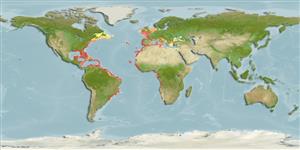Actinopterygii (ray-finned fishes) >
Perciformes (Perch-likes) >
Scombridae (Mackerels, tunas, bonitos) > Scombrinae
Etymology: Euthynnus: Greek, eu = good + Greek, thynnos = tunna (Ref. 45335).
Environment / Climate / Range
Ecology
Marine; brackish; reef-associated; oceanodromous (Ref. 51243); depth range 1 - 150 m (Ref. 28173). Tropical, preferred 24°C (Ref. 107945); 56°N - 30°S, 92°W - 42°E
Atlantic Ocean: in tropical and subtropical waters, including the Mediterranean, Black Sea, Caribbean Sea and Gulf of Mexico. Highly migratory species, Annex I of the 1982 Convention on the Law of the Sea (Ref. 26139).
Length at first maturity / Size / Weight / Age
Maturity: Lm 41.8 range ? - 60 cm
Max length : 122 cm TL male/unsexed; (Ref. 26340); common length : 80.0 cm TL male/unsexed; (Ref. 5217); max. published weight: 16.5 kg (Ref. 40637); max. reported age: 10 years (Ref. 28173)
Dorsal
spines
(total): 15 - 16;
Dorsal
soft rays
(total): 11-13;
Anal
spines: 0;
Anal
soft rays: 11 - 15;
Vertebrae: 39. Anterior spines of first dorsal fin much higher than the those mid-way, giving the fin a strongly concave outline. Interpelvic process small and bifid. Body naked except for corselet and lateral line. Swim bladder absent. Incipient protuberances on 33rd and 34th vertebrae. Back with broken oblique stripes (Ref. 168). Caudal peduncle with 7-8 finlets. Dark stripes on the back and with 3-7 dark spots between pelvic and pectoral fins (Ref. 35388).
Found in neritic waters close inshore (Ref. 13628). This schooling species is an opportunistic predator which feeds on virtually everything within its range, i.e. crustaceans, fishes (mainly clupeoid), squids, heteropods and tunicates. Eggs and larvae are pelagic (Ref. 6769). Specialized traps (madragues) are used in Tunisia and Morocco. Diving bird flocks may indicate large schools (Ref. 9710). Utilized fresh, dried-salted, smoked, canned and frozen (Ref. 9987). A popular game fish (Ref. 9710).
Eggs are shed in several batches when the water is warmest.
Collette, B.B. and C.E. Nauen, 1983. FAO Species Catalogue. Vol. 2. Scombrids of the world. An annotated and illustrated catalogue of tunas, mackerels, bonitos and related species known to date. Rome: FAO. FAO Fish. Synop. 125(2):137 p. (Ref. 168)
IUCN Red List Status (Ref. 115185)
CITES (Ref. 94142)
Not Evaluated
Threat to humans
Reports of ciguatera poisoning (Ref. 30303)
Human uses
Fisheries: commercial; gamefish: yes
Tools
Special reports
Download XML
Internet sources
Estimates of some properties based on models
Phylogenetic diversity index (Ref.
82805): PD
50 = 0.6250 [Uniqueness, from 0.5 = low to 2.0 = high].
Bayesian length-weight: a=0.00977 (0.00834 - 0.01144), b=3.07 (3.03 - 3.11), in cm Total Length, based on LWR estimates for this species (Ref.
93245).
Trophic Level (Ref.
69278): 4.5 ±0.0 se; Based on diet studies.
Resilience (Ref.
69278): Medium, minimum population doubling time 1.4 - 4.4 years (K=0.13-0.22; tm=2; tmax=8; Fec=71,000).
Prior r = 0.64, 2 SD range = 0.36 - 1.14, log(r) = -0.45, SD log(r) = 0.29, Based on: 1 M, 7 K, 2 tgen, 2 tmax, 2 Fec records
Vulnerability (Ref.
59153): High vulnerability (57 of 100) .
